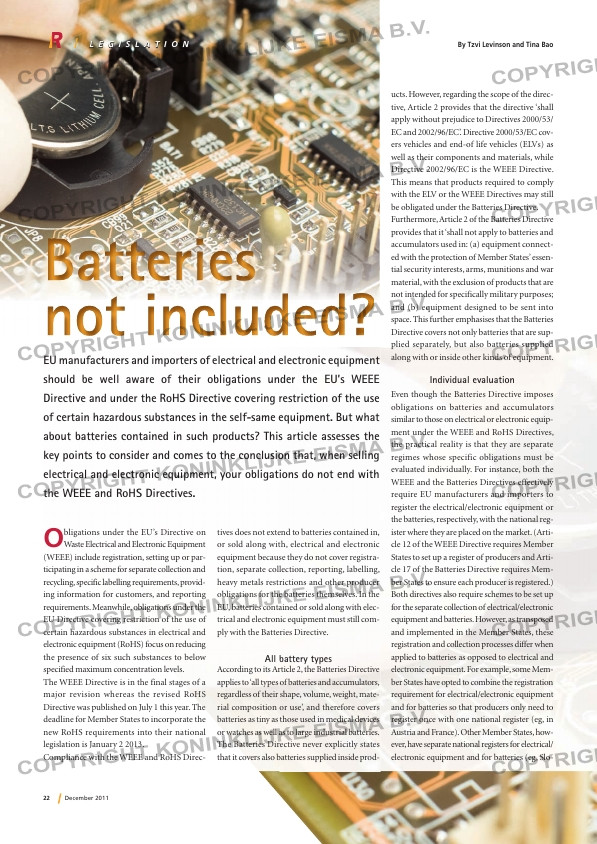Page 22 from: December 2011

22 December 2011
EU manufacturers and importers of electrical and electronic equipment
should be well aware of their obligations under the EU’s WEEE
Directive and under the RoHS Directive covering restriction of the use
of certain hazardous substances in the self-same equipment. But what
about batteries contained in such products? This article assesses the
key points to consider and comes to the conclusion that, when selling
electrical and electronic equipment, your obligations do not end with
the WEEE and RoHS Directives.
ucts. However, regarding the scope of the direc-
tive, Article 2 provides that the directive ‘shall
apply without prejudice to Directives 2000/53/
EC and 2002/96/EC’. Directive 2000/53/EC cov-
ers vehicles and end-of life vehicles (ELVs) as
well as their components and materials, while
Directive 2002/96/EC is the WEEE Directive.
This means that products required to comply
with the ELV or the WEEE Directives may still
be obligated under the Batteries Directive.
Furthermore, Article 2 of the Batteries Directive
provides that it ‘shall not apply to batteries and
accumulators used in: (a) equipment connect-
ed with the protection of Member States’ essen-
tial security interests, arms, munitions and war
material, with the exclusion of products that are
not intended for specifically military purposes;
and (b) equipment designed to be sent into
space. This further emphasises that the Batteries
Directive covers not only batteries that are sup-
plied separately, but also batteries supplied
along with or inside other kinds of equipment.
Individual evaluation
Even though the Batteries Directive imposes
obligations on batteries and accumulators
similar to those on electrical or electronic equip-
ment under the WEEE and RoHS Directives,
the practical reality is that they are separate
regimes whose specific obligations must be
evaluated individually. For instance, both the
WEEE and the Batteries Directives effectively
require EU manufacturers and importers to
register the electrical/electronic equipment or
the batteries, respectively, with the national reg-
ister where they are placed on the market. (Arti-
cle 12 of the WEEE Directive requires Member
States to set up a register of producers and Arti-
cle 17 of the Batteries Directive requires Mem-
ber States to ensure each producer is registered.)
Both directives also require schemes to be set up
for the separate collection of electrical/electronic
equipment and batteries. However, as transposed
and implemented in the Member States, these
registration and collection processes differ when
applied to batteries as opposed to electrical and
electronic equipment. For example, some Mem-
ber States have opted to combine the registration
requirement for electrical/electronic equipment
and for batteries so that producers only need to
register once with one national register (eg, in
Austria and France). Other Member States, how-
ever, have separate national registers for electrical/
electronic equipment and for batteries (eg, Slo-
Obligations under the EU’s Directive on Waste Electrical and Electronic Equipment
(WEEE) include registration, setting up or par-
ticipating in a scheme for separate collection and
recycling, specific labelling requirements, provid-
ing information for customers, and reporting
requirements. Meanwhile, obligations under the
EU Directive covering restriction of the use of
certain hazardous substances in electrical and
electronic equipment (RoHS) focus on reducing
the presence of six such substances to below
specified maximum concentration levels.
The WEEE Directive is in the final stages of a
major revision whereas the revised RoHS
Directive was published on July 1 this year. The
deadline for Member States to incorporate the
new RoHS requirements into their national
legislation is January 2 2013.
Compliance with the WEEE and RoHS Direc-
tives does not extend to batteries contained in,
or sold along with, electrical and electronic
equipment because they do not cover registra-
tion, separate collection, reporting, labelling,
heavy metals restrictions and other producer
obligations for the batteries themselves. In the
EU, batteries contained or sold along with elec-
trical and electronic equipment must still com-
ply with the Batteries Directive.
All battery types
According to its Article 2, the Batteries Directive
applies to ‘all types of batteries and accumulators,
regardless of their shape, volume, weight, mate-
rial composition or use’, and therefore covers
batteries as tiny as those used in medical devices
or watches as well as to large industrial batteries.
The Batteries Directive never explicitly states
that it covers also batteries supplied inside prod-
L E G I S L A T I O N By Tzvi Levinson and Tina Bao
Batteries
not included?
p22_WEEE-Battery Directive.indd 22 30-11-11 08:52



